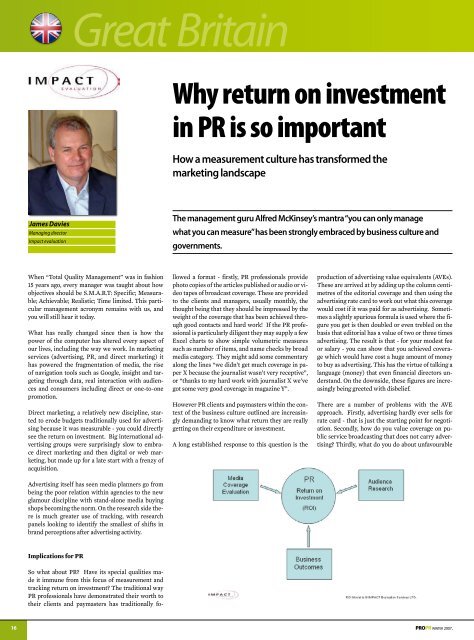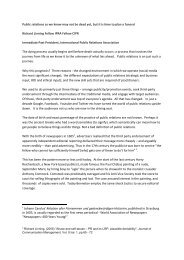CASE STUDY Pfizer's PR campaign „Openly about sex“ - PRO.PR
CASE STUDY Pfizer's PR campaign „Openly about sex“ - PRO.PR
CASE STUDY Pfizer's PR campaign „Openly about sex“ - PRO.PR
You also want an ePaper? Increase the reach of your titles
YUMPU automatically turns print PDFs into web optimized ePapers that Google loves.
.<br />
James Davies<br />
Managing director<br />
Impact evaluation<br />
Great Britain<br />
When “Total Quality Management” was in fashion<br />
15 years ago, every manager was taught <strong>about</strong> how<br />
objectives should be S.M.A.R.T: Specific; Measurable;<br />
Achievable; Realistic; Time limited. This particular<br />
management acronym remains with us, and<br />
you will still hear it today.<br />
What has really changed since then is how the<br />
power of the computer has altered every aspect of<br />
our lives, including the way we work. In marketing<br />
services (advertising, <strong>PR</strong>, and direct marketing) it<br />
has powered the fragmentation of media, the rise<br />
of navigation tools such as Google, insight and targeting<br />
through data, real interaction with audiences<br />
and consumers including direct or one-to-one<br />
promotion.<br />
Direct marketing, a relatively new discipline, started<br />
to erode budgets traditionally used for advertising<br />
because it was measurable - you could directly<br />
see the return on investment. Big international advertising<br />
groups were surprisingly slow to embrace<br />
direct marketing and then digital or web marketing,<br />
but made up for a late start with a frenzy of<br />
acquisition.<br />
Advertising itself has seen media planners go from<br />
being the poor relation within agencies to the new<br />
glamour discipline with stand-alone media buying<br />
shops becoming the norm. On the research side there<br />
is much greater use of tracking, with research<br />
panels looking to identify the smallest of shifts in<br />
brand perceptions after advertising activity.<br />
Implications for <strong>PR</strong><br />
So what <strong>about</strong> <strong>PR</strong>? Have its special qualities made<br />
it immune from this focus of measurement and<br />
tracking return on investment? The traditional way<br />
<strong>PR</strong> professionals have demonstrated their worth to<br />
their clients and paymasters has traditionally fo-<br />
Why return on investment<br />
in <strong>PR</strong> is so important<br />
How a measurement culture has transformed the<br />
marketing landscape<br />
The management guru Alfred McKinsey’s mantra “you can only manage<br />
what you can measure” has been strongly embraced by business culture and<br />
governments.<br />
llowed a format - firstly, <strong>PR</strong> professionals provide<br />
photo copies of the articles published or audio or video<br />
tapes of broadcast coverage. These are provided<br />
to the clients and managers, usually monthly, the<br />
thought being that they should be impressed by the<br />
weight of the coverage that has been achieved through<br />
good contacts and hard work! If the <strong>PR</strong> professional<br />
is particularly diligent they may supply a few<br />
Excel charts to show simple volumetric measures<br />
such as number of items, and name checks by broad<br />
media category. They might add some commentary<br />
along the lines “we didn’t get much coverage in paper<br />
X because the journalist wasn’t very receptive”,<br />
or “thanks to my hard work with journalist X we’ve<br />
got some very good coverage in magazine Y”.<br />
However <strong>PR</strong> clients and paymasters within the context<br />
of the business culture outlined are increasingly<br />
demanding to know what return they are really<br />
getting on their expenditure or investment.<br />
A long established response to this question is the<br />
production of advertising value equivalents (AVEs).<br />
These are arrived at by adding up the column centimetres<br />
of the editorial coverage and then using the<br />
advertising rate card to work out what this coverage<br />
would cost if it was paid for as advertising. Sometimes<br />
a slightly spurious formula is used where the figure<br />
you get is then doubled or even trebled on the<br />
basis that editorial has a value of two or three times<br />
advertising. The result is that - for your modest fee<br />
or salary - you can show that you achieved coverage<br />
which would have cost a huge amount of money<br />
to buy as advertising. This has the virtue of talking a<br />
language (money) that even financial directors understand.<br />
On the downside, these figures are increasingly<br />
being greeted with disbelief.<br />
There are a number of problems with the AVE<br />
approach. Firstly, advertising hardly ever sells for<br />
rate card - that is just the starting point for negotiation.<br />
Secondly, how do you value coverage on public<br />
service broadcasting that does not carry advertising?<br />
Thirdly, what do you do <strong>about</strong> unfavourable<br />
1 <strong>PR</strong>O<strong>PR</strong> winter 2007.



